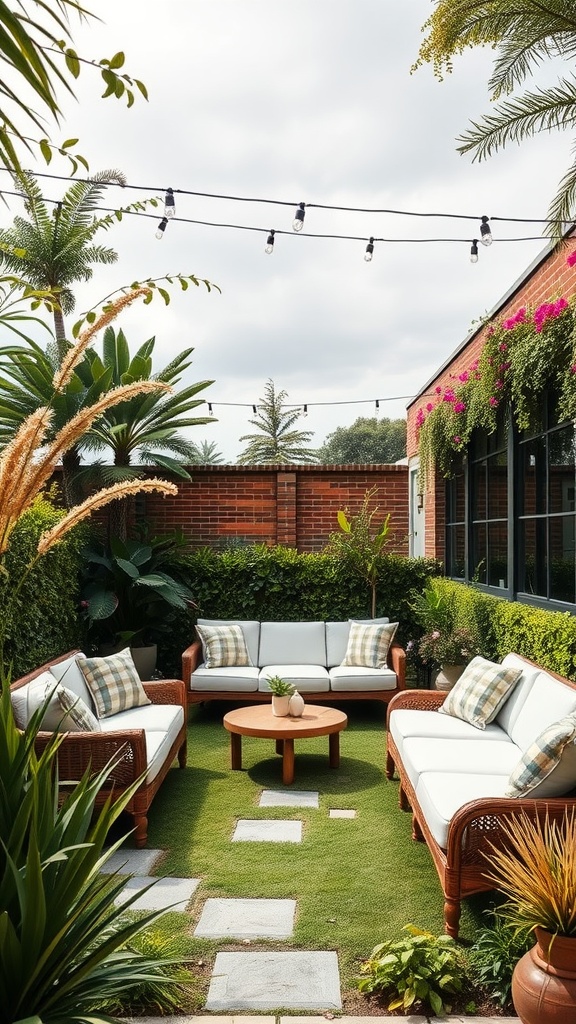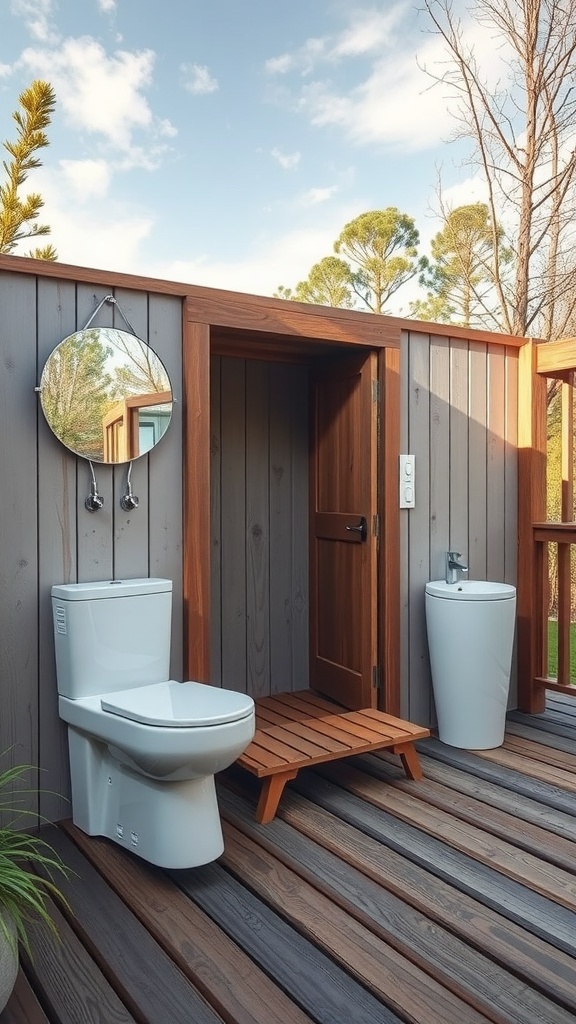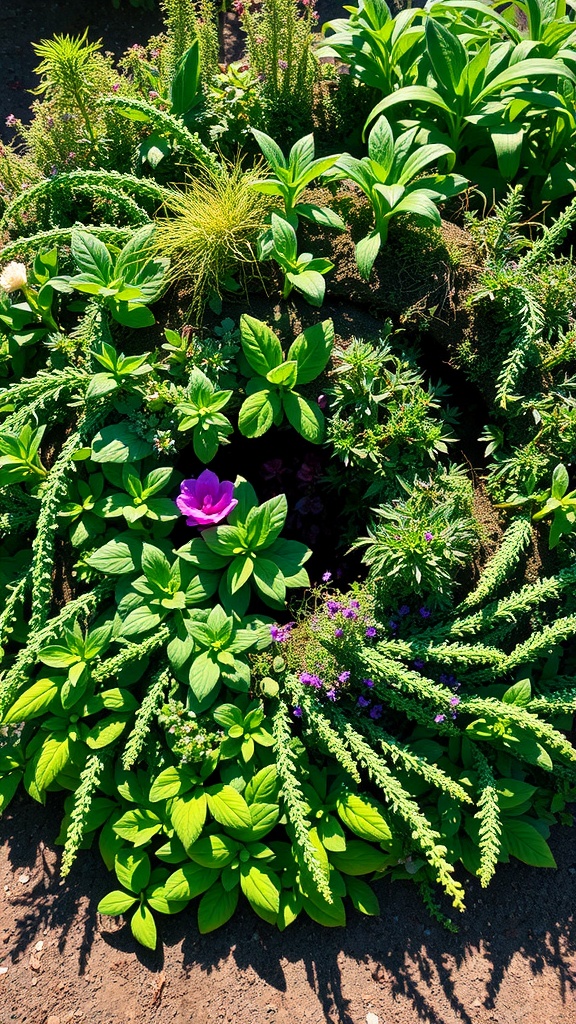Creating a beautiful and functional yard doesn’t have to mean sacrificing sustainability. Swale landscaping—where shallow, sloped ditches are used to manage water runoff—is the perfect solution that marries form and function. Whether you’re dreaming up modern back porch ideas, upgrading your back porch décor, or seeking ways to highlight your outdoor living area, these creative swale ideas will inspire and guide you.
Let’s dive into 17 practical, beautiful, and eco-friendly swale landscaping ideas that can enhance your outdoor oasis.
1. Native Plant Lined Swales

One of the most eco-friendly and low-maintenance ways to landscape your swale is by lining it with native plants. These species are naturally adapted to your climate, which means they require less water, fewer fertilizers, and minimal care.
In the USA, native plants like Black-Eyed Susans, coneflowers, and little bluestem grasses thrive in swales. When you choose the right mix of native perennials and grasses, they not only help slow down and filter water runoff but also attract pollinators like butterflies and bees.
This technique turns a functional water diversion system into a blooming garden bed. It’s a seamless blend of beauty and sustainability that complements both rustic and modern back porch ideas.
The key to this idea is layering your plants. Use taller species at the center or base of the swale and lower-growing ones on the edges. This creates a natural, flowing design that feels intentional, not engineered.
2. Decorative Rock Channels
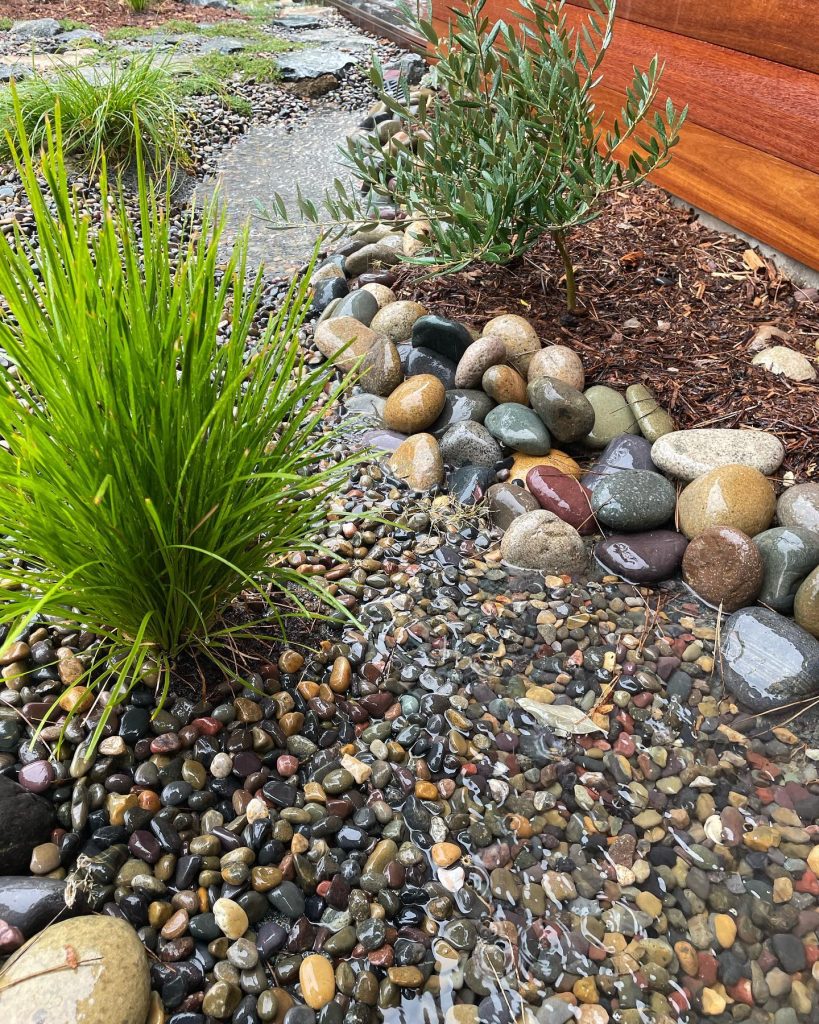
For homeowners who lean toward minimalism or modern patio furniture aesthetics, decorative rock channels offer a sleek solution. Think of a dry creek bed lined with river rocks or polished pebbles—strategically arranged to direct water flow while adding texture and contrast to your yard.
Rocks are not only beautiful, but they’re durable and require virtually zero maintenance. You can use different shades—white quartz, grey granite, or even black lava rock—for a more customized look that ties into your overall outdoor living vibe.
This swale idea is particularly effective if you’re trying to bridge the look between a manicured lawn and a more wild, garden-inspired area. It’s great for reducing erosion and it pairs well with modern back porch decor themes that value clean lines and natural materials.
Add accent boulders or a small wooden bridge for a whimsical or Zen garden effect.
3. Rain Garden Swales
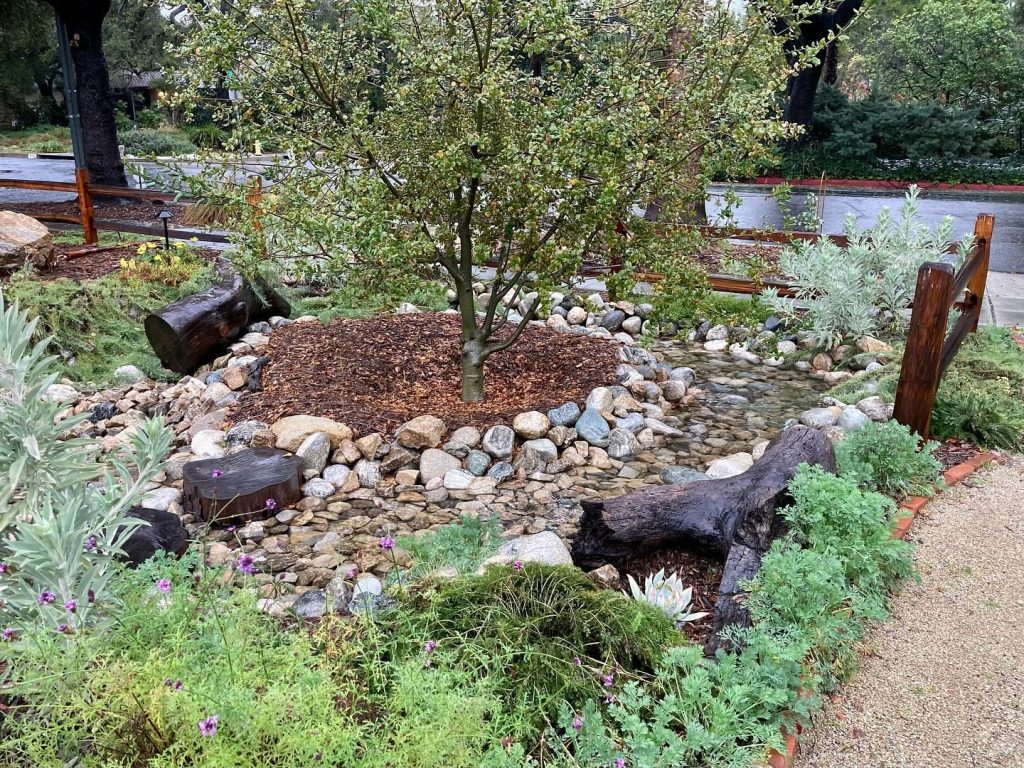
Rain gardens are shallow, planted depressions that collect and filter stormwater. When combined with a swale, you get the best of both worlds—a functional drainage solution that doubles as a lush garden feature.
To build this, you’ll contour the swale so that water is directed to a wider basin area planted with water-loving species such as Joe Pye Weed, blue flag iris, or swamp milkweed.
What makes rain garden swales stand out is how much biodiversity they invite into your backyard. Frogs, birds, and pollinators will find a haven, while you enjoy a colorful, ever-changing landscape throughout the seasons.
Design-wise, rain garden swales are flexible. You can go cottage-style with dense flower beds or keep things sleek with native grasses and stone edging. Either way, this idea integrates beautifully into your backyard landscape while keeping your drainage system discrete and effective.
4. Grassy Berm Swales
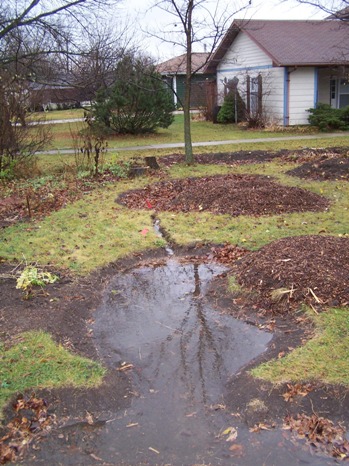
If you prefer open, green space with a sculpted look, grassy berm swales are ideal. Here, gently raised berms are formed on either side of a shallow trench to help redirect water. The result is a dynamic terrain feature that mimics natural rolling hills.
Use drought-tolerant grasses like fescue or buffalo grass for a low-maintenance lawn alternative. These berms look polished and purposeful, adding subtle movement and interest to flat yards.
Grassy berms are perfect for creating privacy or defining zones in larger yards—especially helpful if you have a modern back porch setup that opens into a broader landscape. These mounds can help separate your lounging area from the rest of the garden without the need for fences or walls.
Add some wildflowers on the slope for a meadow-inspired twist that softens the look.
5. Swale Pathways with Stepping Stones
Source
Looking to incorporate function into your design? Turning a swale into a pathway is a clever way to get dual use from your landscaping. By adding large stepping stones or flagstone pavers across the swale bed, you allow water to pass while creating a defined walking route.
This idea is perfect for homeowners who love practical outdoor living spaces. You can use these paths to connect your patio to a fire pit, garden, or back porch sitting area. To ensure drainage remains effective, surround the stones with gravel or mulch that won’t wash away.
It also invites creativity—play with stone shapes, colors, and spacing to match your back porch decor or patio furniture style. Whether you want rustic charm or a more polished finish, swale pathways can be tailored to fit your aesthetic.
6. Edible Garden Swales
Source
Swales aren’t just for flowers and grass—they can be the backbone of a thriving edible garden. By designing your swale to capture and retain moisture, you create a microclimate that supports fruit trees, berry bushes, herbs, and vegetables.
In fact, this method has roots in permaculture, where water conservation and soil health are key. You can plant herbs like rosemary or thyme along the higher edges and moisture-loving veggies like kale or lettuce at the base.
This setup is especially effective for raised areas near the porch, letting you harvest food while enjoying your outdoor space. It brings sustainability right to your doorstep, quite literally.
Plus, edible swales offer a unique talking point for guests—what’s more impressive than a garden that waters itself?
7. Decorative Bridge Over Swales
Source
Adding a small decorative bridge over your swale can elevate it from a drainage necessity to a landscape centerpiece. Whether made of wood, metal, or even concrete, a well-placed bridge creates a sense of flow and connection between different parts of your yard.
This feature works especially well if your swale runs across your yard in a visible location. Instead of hiding it, you can highlight it with thoughtful hardscaping that enhances your outdoor living ambiance.
Bridges also blend beautifully with modern patio furniture and outdoor lighting schemes, providing a bit of structure and whimsy. You can choose a Japanese-style arched bridge for a tranquil, meditative vibe or a flat, minimal design for a modern look.
And yes, the kids (and pets!) will love it too.
8. Mulched Swale Beds
Source
Mulching your swale is one of the easiest, most budget-friendly ways to maintain it. A thick layer of organic mulch like bark, straw, or shredded leaves helps slow water, retain soil moisture, and prevent weed growth.
Beyond function, mulch adds an earthy texture that complements natural garden spaces and modern landscaping styles alike. It works wonderfully alongside stone accents, rustic wooden elements, or sleek outdoor seating.
To elevate the look, edge the swale with bricks, logs, or decorative metal. This creates a tidy border that keeps mulch in place and boosts curb appeal.
Mulched swales are great for busy homeowners who want something low-effort but still stylish and effective.
9. Gabion Wall Swales
Source
If you love a bold, architectural statement in your garden, consider using gabion walls to line your swales. These wire cages filled with rocks offer excellent erosion control while creating a rugged, modern aesthetic.
Gabion structures are ideal for homes with sloped yards or high water runoff. They can be used to support swale banks or even form a cascading design if you’re dealing with elevation changes.
They pair beautifully with modern back porch ideas, especially when you want to create a cohesive look using industrial materials. And they’re surprisingly versatile—you can fill the cages with colorful stones, glass pieces, or even reclaimed materials.
These walls also double as seating or decorative dividers, adding structure to your yard in a creative way.
10. Integrated Lighting for Night Appeal
Source
Why let your swale disappear after sunset? Adding integrated lighting—like solar path lights, LED uplights, or low-voltage string lights—can highlight your swale as a nighttime landscape feature.
Not only does this increase safety (no one wants to accidentally step into a swale), but it adds a soft, inviting glow to your yard. It’s a great way to tie your swale into the rest of your outdoor living space, especially if your back porch decor includes lighting elements.
Strategically placed lights along the swale can create a magical effect, especially when combined with water-loving plants or reflective rocks. You can even program smart lights to change color or brightness depending on the mood or season.
Lighting makes your swale more than functional—it becomes part of the atmosphere.
11. Swales with Wooden Retaining Walls
Source
Wooden retaining walls can give your swale structure and style while supporting the natural contours of your yard. These walls are especially useful if you have sloped terrain where runoff needs to be managed more precisely.
The beauty of using wood is its versatility—it can fit into a rustic, farmhouse-style yard just as easily as it complements sleek, modern back porch decor. Opt for treated timber or cedar to ensure durability against moisture and rot.
Design-wise, you can keep the lines clean and square for a contemporary vibe, or stagger the boards for a more natural, handcrafted look. Plant cascading greenery or trailing flowers like creeping Jenny along the top edge to soften the structure and add layers of color and movement.
Wooden walls also provide visual boundaries, creating neat, defined swale spaces that look intentional and curated. It’s a practical, elegant solution that brings order to your landscape without losing charm.
12. Stone-Tiered Swales for Elevation
Source
If your backyard has a steep slope or uneven grading, stone-tiered swales are an eye-catching and highly effective solution. These swales are created in levels, with each tier acting as a mini basin to slow and spread water.
Stacked stone or flagstone walls can be used to separate the tiers, providing both function and a beautifully rugged appearance. This idea mirrors natural landscapes like mountain brooks and terraces, bringing that organic flow right into your backyard.
Tiered swales work well when combined with ornamental grasses, succulents, or even small shrubs. The layering offers a unique opportunity for dynamic planting designs, giving depth and visual interest to your outdoor space.
This option especially shines in homes with a view—whether you’re sipping coffee on a modern patio set or entertaining guests under string lights, the tiered structure draws the eye outward and down, extending your landscape’s appeal.
13. Swale Integrated Seating
Source
Yes, your swale can even become a seating area! With the right design, you can install benches or built-in seating along your swale’s edge, turning a functional drainage system into a comfy place to relax.
This concept is perfect for backyards focused on outdoor living. Picture a swale lined with smooth stone, bordered by a natural wood bench and flanked by lush plantings—it’s peaceful, practical, and totally Instagram-worthy.
You can use built-in concrete seating for a minimalist look or opt for raised garden beds that double as bench edges. Swale-integrated seating invites you and your guests to enjoy the beauty of your landscaping up close.
It’s a clever way to blend hardscaping with greenery, especially when paired with modern back porch ideas that prioritize versatility and comfort.
14. Functional Swales as Play Spaces
Source
If you have children or pets, why not design your swale to double as a playful, interactive space? With a gentle slope and soft, grass-covered basin, a swale can become a seasonal stream for play, or simply a grassy nook for lounging, picnicking, or make-believe adventures.
To make it safe and fun, keep the grade smooth and shallow, and use soft landscaping materials—think fine mulch, clover, or turfgrass. You can even place stepping stones or wood slices for hopping paths and install small logs or stumps for climbing.
It’s a great way to make your yard more dynamic and family-friendly while still preserving the swale’s core function of water management.
Integrating a swale into a play area offers you the best of both worlds: responsible landscaping and joyful, everyday use that grows with your family.
15. Flower-Filled Swales for Seasonal Color
Source
For those who crave color and vibrance in every season, flower-filled swales are a dream come true. You can treat your swale like a living bouquet by planting a mix of seasonal blooms that thrive in varying moisture levels.
Choose early bloomers like daffodils and crocuses for spring, followed by summer perennials like bee balm and black-eyed Susans. For autumn, asters and ornamental grasses keep the color going well into the cooler months.
The swale’s unique microclimate—moist at the bottom, drier along the sides—lets you get creative with plant placement. Use it as an opportunity to showcase your gardening flair, whether you lean toward wildflower chaos or tightly coordinated color schemes.
This style also complements modern porch decor, offering a constantly evolving view right from your favorite lounge chair. Just be prepared for compliments and lots of butterflies.
16. Gravel Swales for a Modern Look
Source
Gravel swales are perfect for those who love modern, low-maintenance landscapes. By filling your swale with crushed gravel, pea stone, or decomposed granite, you create a clean, minimalist channel that quietly does its job without calling too much attention.
This type of swale integrates seamlessly with modern patio furniture, back porch seating areas, and xeriscaped gardens. Use dark gravel for contrast or lighter tones to brighten shaded spaces.
For extra flair, define the swale edges with steel edging or concrete borders, giving it a crisp, architectural finish. You can also insert narrow garden lights along the path to highlight the texture and shape in the evening.
Best of all, gravel swales are incredibly durable and ideal for regions with little rainfall—they won’t erode easily and don’t require replanting each year.
17. Curved Swale Design for Visual Flow
Source
Instead of straight, utilitarian lines, consider designing your swale with graceful curves that follow the natural lay of the land. Curved swales are not only more effective in slowing and spreading water, but they also add an elegant, organic feel to your yard.
This concept works especially well in larger spaces, where you can let the swale meander like a natural stream. The curves create pockets that are perfect for grouping plants, rocks, and decorative features.
Visually, curved swales guide the eye through the landscape, enhancing flow and cohesion between your outdoor zones. From your back porch seating to your garden nook or fire pit, it all starts to feel like part of one larger, unified design.
Whether you’re working with a professional landscaper or doing it yourself, incorporating curves makes your outdoor space more inviting and inspired.
Conclusion: Swale Landscaping is More Than Just Drainage
Swale landscaping has come a long way from being a purely functional part of the yard. Today, it’s a canvas for creativity, sustainability, and personal style. From decorative rock beds to rain gardens and edible plantings, the possibilities are nearly endless—and they all help protect your property and the environment at the same time.
Whether your aesthetic leans toward modern patio furniture, rustic farmhouse charm, or low-maintenance outdoor living, swales can be customized to complement and elevate your space.
So next time you’re considering back porch decor or a yard upgrade, don’t overlook your swale—it might just be the feature that brings your entire outdoor vision together.
With these 17 inspiring ideas, you’re not just managing water—you’re designing beauty with purpose.
Happy landscaping!
